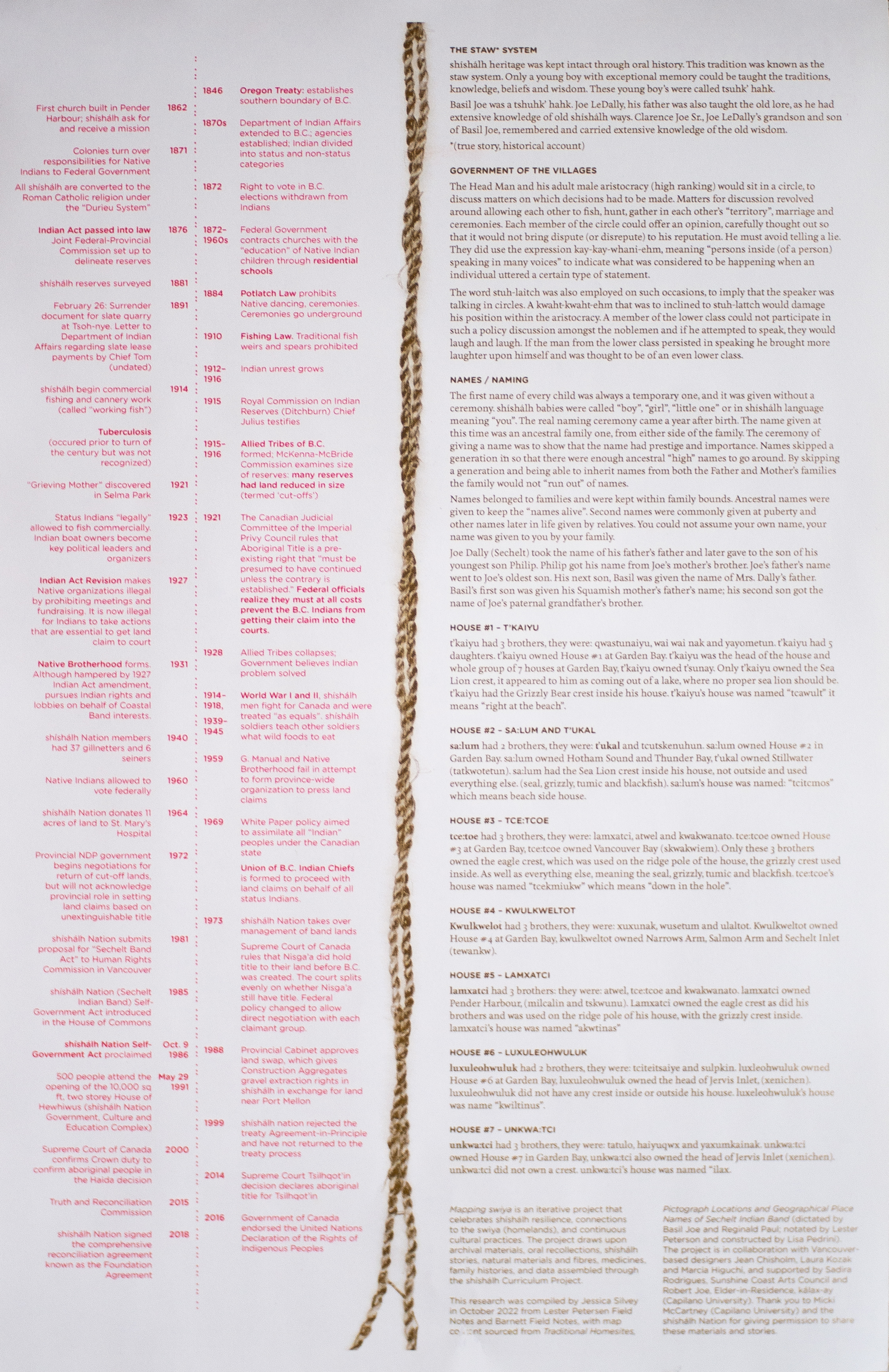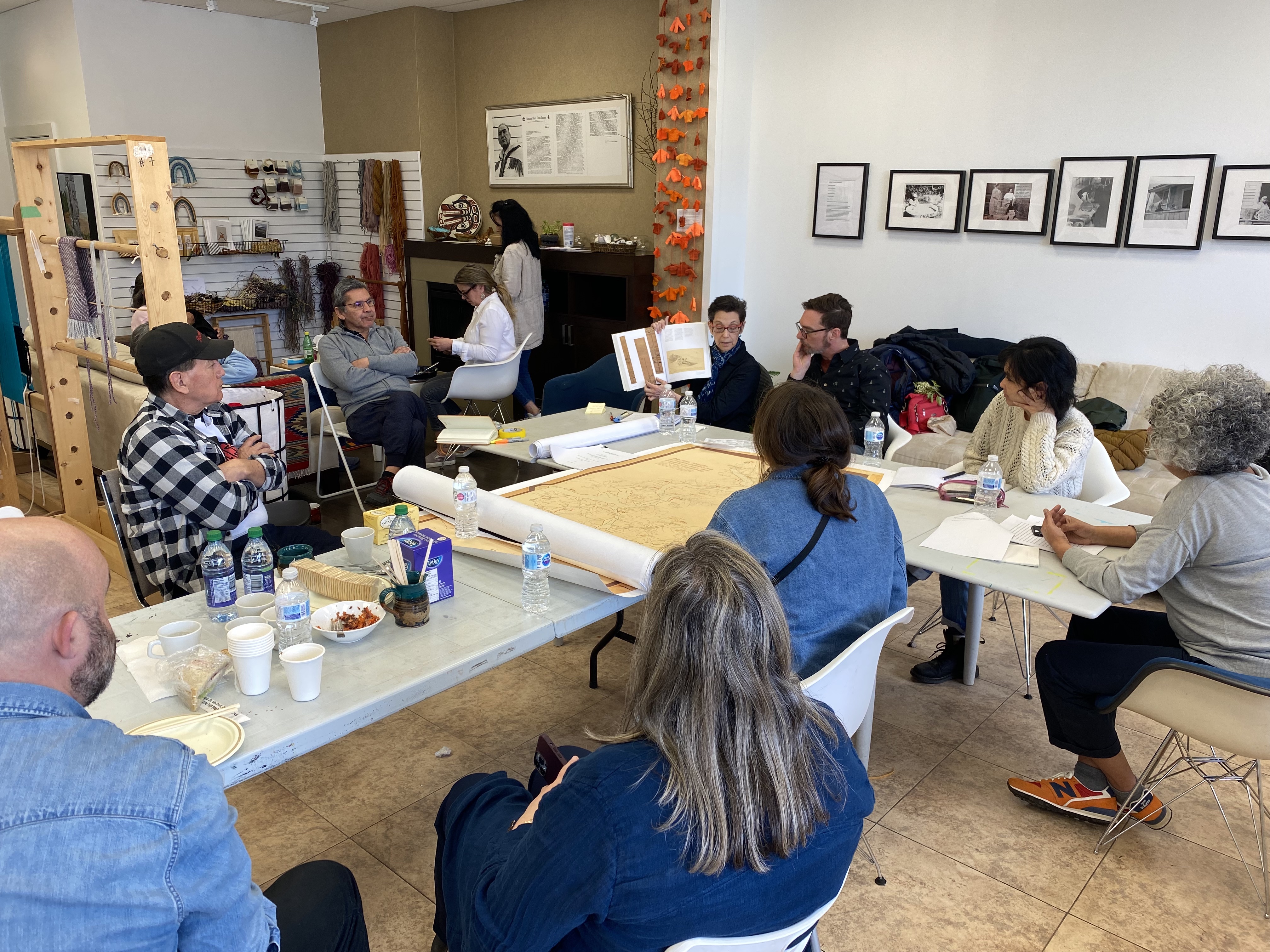Mapping swiya
2022-2024
2022-2024
Mapping swiya: A case study in place-based research ethics, researched and designed with Laura Kozak
and Marcia Higuchi, in partnership with Sunshine Coast Arts
Council.
In 2022, Robert Joe, shíshálh Elder-in-Residence at Capilano University and Coast Salish master weaver Jessica Silvey began assembling a variety of sources to map their Nation’s history and territory in partnership with Sadira Rodrigues, Director/ Curator, Sunshine Coast Arts Council (SCAC). This group engaged a design team from Emily Carr (Jean Chisholm, Marcia Higuchi and Laura Kozak) to prototype a translation of this material to large-scale form for the CapU campus, where many of the Nation’s youth begin post-secondary studies.
Phase One (completed November 2022) includes a wall-sized map of the shíshálh swiya (homelands) and traditional place names alongside a 24’ timeline detailing specifics of epidemics, changes to land title, residential school, cultural events and images held within the Nation’s archives. Simple prints and images were wheat-pasted to the hallway of CapU, creating an accessible model for students and teachers to add to.
Phase Two (Spring 2024) designed this map into riso-printed poster to be shared at community events, layering in additional histories and stories from local knowledge-keepers, gathered in response to the wall mural. Understanding the factual truths and specific details of the impacts of colonialism is fundamental for healing and resurgence of story and pride in culture.
In 2022, Robert Joe, shíshálh Elder-in-Residence at Capilano University and Coast Salish master weaver Jessica Silvey began assembling a variety of sources to map their Nation’s history and territory in partnership with Sadira Rodrigues, Director/ Curator, Sunshine Coast Arts Council (SCAC). This group engaged a design team from Emily Carr (Jean Chisholm, Marcia Higuchi and Laura Kozak) to prototype a translation of this material to large-scale form for the CapU campus, where many of the Nation’s youth begin post-secondary studies.
Phase One (completed November 2022) includes a wall-sized map of the shíshálh swiya (homelands) and traditional place names alongside a 24’ timeline detailing specifics of epidemics, changes to land title, residential school, cultural events and images held within the Nation’s archives. Simple prints and images were wheat-pasted to the hallway of CapU, creating an accessible model for students and teachers to add to.
Phase Two (Spring 2024) designed this map into riso-printed poster to be shared at community events, layering in additional histories and stories from local knowledge-keepers, gathered in response to the wall mural. Understanding the factual truths and specific details of the impacts of colonialism is fundamental for healing and resurgence of story and pride in culture.




Conditions for Collaboration
2024
2024
Essay and workshop looking at collaborative teaching within an art and design university. Produced with Annie Canto, with support from the ECUAD Teaching and Learning Centre.
Read essay
Read essay
Palestine A-Z: An Illustrated Poem
2024
2024
Palestine A-Z: An Illustrated Poem envisions Mosab Abu Toha’s poem “Palestine A-Z” as an illustrated introduction to revolutionary will in Palestine. The poem sketches Palestine through the 26 letters of the English alphabet, where each letter presents notes, reflections, memories, lamentations, and questions on uprooting, exile, and home. The community of artists drawn together to produce these cards experiences the poem from diverse and varying perspectives. Those of us with family history from Palestine connect intimately with the poem’s existential meditations on sumud. Those of us descended from dislocations produced by state violence elsewhere in the world recognize the poem’s critique of borders, militarization, apartheid, and genocide. Those of us who recently joined the struggle for Palestine study the poem as testament to life and death in occupied Palestine. None of us have been to Palestine. All of us are activated in transnational anti-colonial work demonstrated here on the occupied territories that are home to xʷməθkʷəy̓əm Nation, Sḵwx̱wú7mesh Úxwumixw Nation, and səlilwətaɬ Nation.
Illustrations by community of artists during a reading of the poem March, 2024. Zine design by Jean Chisholm and Gabe Wong, printed on risograph. Introduction written by Sue Shon.
We are indebted to Mosab Abu Toha who inspired this project and are grateful to his powerful work as writer, educator, and librarian.
Illustrations by community of artists during a reading of the poem March, 2024. Zine design by Jean Chisholm and Gabe Wong, printed on risograph. Introduction written by Sue Shon.
We are indebted to Mosab Abu Toha who inspired this project and are grateful to his powerful work as writer, educator, and librarian.










